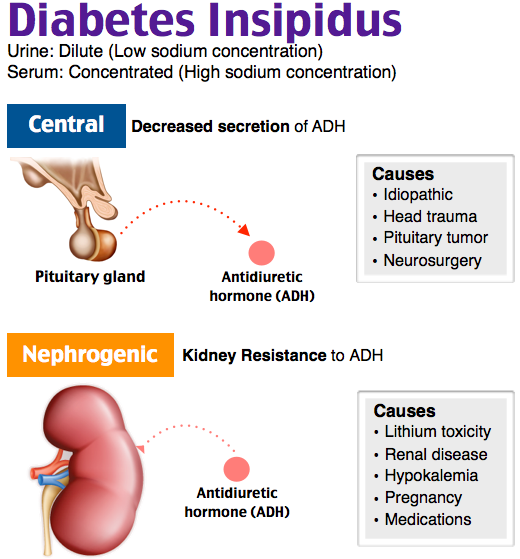What is diabetes insipidus?
Diabetes insipidus is the consequence of primary or secondary deficiency of antidiuretic hormone (ADH) by hypothalamic-pituitary damage. This deficiency is responsible for primary polyuria (over 30 ml / kg) hypotonic and secondary polydipsia.
Diabetes insipidus, a disease that has nothing to do with blood sugar. At first reading, people may be tempted to believe that diabetes insipidus is another form of diabetes, but the name is similar only because of the manifestations – thirst and excessive urination – having nothing to do with blood sugar. For this reason it is better to know what this disease means so as not to confuse it with diabetes.
What exactly is this condition, how does it manifest itself, what tests are needed to establish the diagnosis and what are the treatment methods we find out below.
Diabetes insipidus is a disease caused by improper kidney function due to the absence or malfunction of the antidiuretic hormone ADH called vasopressin. This hormone is usually secreted in a region of the brain called the hypothalamus, which is then stored in the pituitary gland, where it is eliminated as needed. If this hormone does not fulfill its function or is completely absent, the phenomenon called polyuria appears, ie the emission of a large amount of urine, but diluted.
There are two forms of diabetes insipidus:
- Central – when not enough vasopressin is produced
- Nephrogenic – when the kidneys do not react properly in the presence of vasopressin
Categories of people at risk
Diabetes insipidus occurs more frequently among people suffering from certain kidney diseases (nephrotic syndrome, kidney failure, pyelonephritis) and those with high levels of calcium in the blood. Also, the condition can occur with a diet that does not include enough protein or in people on a salt-free diet for a long time.
Symptoms of diabetes insipidus
The main symptoms of diabetes insipidus are excessive thirst and elimination of large amounts of diluted urine (between 5 and 8 liters per day), light in color. If the patient chooses not to satisfy his need to consume fluids, in order not to have to go to the toilet so often, dehydration can occur, which can be manifested by weakness, lethargy, fatigue, muscle cramps and irritability.
Diabetes insipidus diagnosis
Frequent urination and excessive thirst can arouse the suspicion of diabetes, but it can also be diabetes insipidus. To determine exactly the condition you are suffering from, you should consult your doctor as soon as you notice such symptoms and perform a series of blood and urine tests recommended by him. It is very likely that your doctor will measure the level of salt in your blood and urine or give you an antidiuretic hormone replacement to see how your kidneys react.
The results of laboratory tests and the response of renal function help the doctor to establish an accurate diagnosis and recommend appropriate treatment.
How to treat it
If you have been diagnosed with central diabetes insipidus, you do not have to worry about treatment because there are drugs that contain desmopressin, a synthetic hormone that successfully replaces the action of vasopressin.
Usually, such drugs are sold in the form of nasal sprays, tablets or injections, but pills may be needed to help a better functioning of the specific treatment. They are administered only under specialized medical guidance.
In contrast, nephrogenic diabetes insipidus is more difficult to treat and aims in particular to adopt a low-salt diet and relieve symptoms with diuretics or anti-inflammatory drugs.
Complications
In the absence of proper treatment, diabetes insipidus does not cause chronic kidney failure and does not involve dialysis. Instead, your body does not retain enough fluids to function properly, so you will be more prone to dehydration and deficiencies of minerals, especially sodium, potassium and calcium.
These complications are manifested by dry mouth, weight loss, headache, low blood pressure, muscle aches and fatigue.
